Welcome to the Izard County Quilt Trail. It was developed by Barbara Carlson with help from other adventurous and creative souls! Here’s a bit of history about the county from Encyclopedia of Arkansas: “Izard County has not changed a great deal since the settlers first arrived. Then and now, oak and pine forests cover much of the southern Ozark hills. The county’s highest elevations are in the Boswell and Sylamore area. These include Brandenburg Mountain (1,099 feet), Thompson Mountain (1,124 feet), and Pilot Knob (1,123 feet). The county has sixty-eight named streams, all of which flow eventually into the White River. Limestone bluffs grace parts of Piney Creek and the White River. Grassy valleys are dotted with small towns, the largest being Horseshoe Bend, Melbourne, Calico Rock, Oxford, and Mt. Pleasant. ” You’ll find exhibits and history at the Calico Rock Museum which is open Tuesday-Friday 9am-5pm and Saturdays 10am-4pm. You’ll enjoy seeing the historic buildings and shops along Main Street, the railroad that separates downtown from the White River and the calico colored bluffs from which the town derived its name. You’ll also want to visit the court square in Melbourne, the county seat. The town is also home of Ozarka College. Horseshoe Bend is a resort and retirement community and is the only town in Arkansas located in three different counties, with the largest portion in Izard County. The name of the town refers to the bend in the Strawberry River. Oxford, Sage, Violet Hill, Brockwell, Mt. Olive, and Mt. Pleasant are smaller towns with their own charm and history. Enjoy your drive through Izard County and enjoy the scenic vistas, historic town squares, colorful quilt patterns, and the stories we share with each block!

104 Main St.
Calico Rock AR
#9-01, Claire’s Garden. The location of this quilt is proof that small places can become hidden treasures. Hidden behind the Marketplace at 104 Main St. in Calico Rock, the garden features native plants and there is a second herb garden just up the stairs. The building behind the quilt was built in 1921 and called the Coal House since it was where folks went to buy coal for their homes. Over the years it may have been part of Perryman’s Hardware, housed the Calico Rock Water Department and, since it was purchased by the Calico Rock Museum, was a Homestead exhibit, a science center and a class room. It is currently called the Easton Center. The quilt design is All Hallows Variation with a twist. Notably, the dominant color in this rendition of the pattern is orange. The Calico Rock School colors are orange and black. The pirate is their mascot. The K-12 school educates about 370 students and has fielded some good basketball teams over the years. Alums include Savannah Skidmore who was Miss Arkansas, then a few years later won Miss Arkansas USA. She finished in the top five at the Miss USA pageant in 2019.
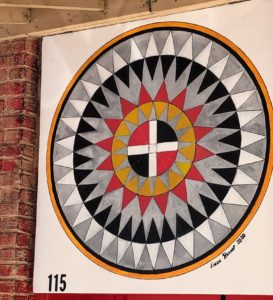
115 Main St.
Calico Rock AR
#9-02, Seminole Star is at 115 Main Street, Calico Rock. Located above the door of a store featuring ice cream, fudge, flavored popcorn and old-fashioned candy, this quilt was painted by Linda Havner. The Encyclopedia of Arkansas provides interesting facts about local Native American history: Many Native American artifacts have been discovered in the area. At the time of the Louisiana Purchase, much of northern Arkansas, including this region, was claimed as hunting ground by the Osage tribe, who lived in southern Missouri. They relinquished their claim to this land in 1808, but ten years later it was made part of a Cherokee reservation. The Cherokee generally lived on the southern part of their reservation in the Arkansas River Valley. However, they invited other tribes to join them on their land, and some Shawnee settlements were established in the Calico Rock (Izard County) area. The area’s first white settlers arrived after a new treaty with the Cherokee ended their reservation in Arkansas in 1828; they had a good relationship with the Shawnee, hunting, farming, and trading together. By 1833, though, the Shawnee had relocated to Texas and to Indian Territory (now Oklahoma). The Benge Trail of Tears passed about three miles east of town. The Flood of 1927 unearthed a Native American burial ground immediately across the river from the business district.
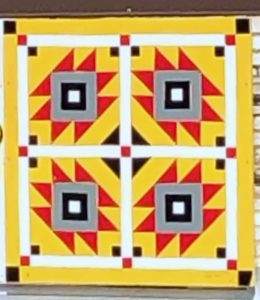
117 Main St.
Calico Rock AR
#9-03, Indian Crossroads, is one of several quilt blocks in Baxter and Izard Counties painted by Linda Havner. Located at 117 Main St., Calico Rock, this block is above the Curious Craftsman shop. The store specializes in art by several local artists including pottery, paintings and many fabric items made by Linda. Items in the shop are all natural for people who like the river, fishing, the woods and nature. Linda’s first store in Topeka, Kansas was a macramé and pottery store named Curious Craftsman and opened in 1976. She has owned other stores in Mountain View, Mountain Home, and Norfork and for a time specialized in quilting. But her stores always focus on good design and creativity. The quilt patterns Linda selects are Indian because her grandmother was full-blooded Cherokee and seemed especially relevant to place in Calico Rock because of the strong area focus on Native American history. The Calico Rock Museum on Main Street provides some interesting background information on Native American history for the interested visitor. Call 870-297-6100 for information regarding museum hours.
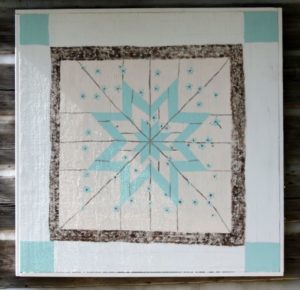
692 Hwy 56
Calico Rock AR
#9-04, The Folded Star Bridal Quilt, is patterned after a quilt that was hand-pieced and quilted by Ruth Turner in 1990 using a pattern from Great American Quilts. It won an award for the most unusual quilt in the Humboldt, Tennessee, Quilt Show in 1992 & 1993 and the People’s Choice Award in 1994. The inner points of the star in each of the twenty blocks in the original quilt are not sewn down and each of the four star layers became gradually smaller creating a 3-D effect. Fredericka Silvey Johns shares, “My Aunt Ruth Edna Silvey Turner, my dad T.J. Silvey’s sister who was also my home economics teacher at Bodcaw, Arkansas in the 1960’s, inscribed on the reverse side of every piece of quilting that she did, and they were MANY, the date and any pertinent information. On this quilt she wrote “Given To Fredericka Nell Silvey Johns 2008”. “To Angela Krosp Baker ‘Someday'”. Angela is my second cousin. Other interesting inscriptions were on the articles which she made on the day and following days of September 11, 2001.” The quilt block is on the Trimble House which was moved to its current location on Highway 56 by an initiative meant to preserve a part of the history of Calico Rock and the area. The block is one of two in Izard County painted by Kimberly Brook Williamson. In 1815, beckoned by pure water, abundant game, virgin forests and no mosquitoes, James Finis Trimble and Phebe Walker homesteaded a tract of land 7 miles north of the Calico Rock Bluffs. By 1860 the cabin was no longer standing. Granted 46 acres by President Buchanan, their eldest son marked short-leaf pine trees all the same diameter (then 80 to 90 years old) and neighbors helped him cut the logs to build the cabin as it stands today. Various owners of the cabin over the years were Justices of the Peace, and, at different times, they used the cabin for weddings and for court. Carl Russell donated the cabin, which was on his property, and Rev. Wayne Wood, then pastor of the Calico Rock Cumberland Presbyterian Church, agreed to be director of the project moving it to its current location across the highway from that very church. Because of the damage by termites and moisture to some of the lowest row of logs, the floor is now one log shorter than the original.
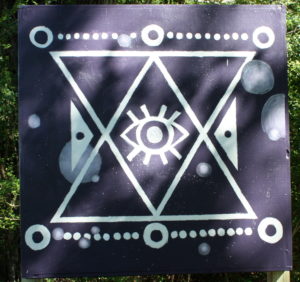
55 Jones St.
Calico Rock AR
#9-05, Ozark Crystal Vibes, is located at 55 Jones St., Calico Rock, Arkansas. The Natural State, along with Brazil, is considered by geologists to offer up from the very earth the highest quality natural quartz crystals in the world. This phenomenon has attracted people interested in the energetic and healing aspects of this amazing and beautiful mineral from ancient times to the present. Native People, indigenous to Arkansas, fashioned their tools and weaponry from quartz crystal. In the early 1900s, the quartz crystal’s ability to maintain a steady vibration led to its use in oscillators for computers, clocks, watches, and radios. The 1970s brought the Crystal Singing Bowls to the attention of the world’s sound healers. These crucibles are a by-product of the semiconductor industry where they are used to grow computer microchips. The precise thickness of each bowl’s wall produces a perfect sine wave tone. Our brain waves in alpha state have the same energetic patterns. When the Crystal Bowl is played it creates a state of harmonic vibration that corrects imbalances in the human body, giving a feeling of peace and relaxation. In 2016, Ozark Crystal Vibes was formed in Calico Rock, Arkansas. This group of people use the Crystal Singing Bowls in their soundscapes to produce a healing energetic environment. You can find more about Ozark Crystal Vibes on their Facebook page. The Ozark Crystal Vibes quilt block was painted by Kimberly Brook Williamson in collaboration with Patricia Kilpatrick, a founder of Ozark Crystal Vibes.
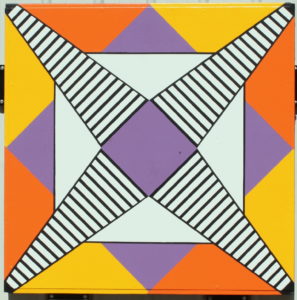
225 Kings Crossing
Calico Rock AR
#9-06, Art Quilt is located at 225 Kings Crossing, Calico Rock. Sometimes the GPS directions stop before you get to 225 Kings Crossing, but just keep going to the end of the road. Even though the street is a dead end, there is a circular drive you can use to get closer to the quilt and to turn around. This quilt block design is a nod to one of the new directions in quilting – Art Quilting. It was designed and painted by Barbara Carlson who is an Art Quilter and quilt designer as well as the founder of the Izard County Quilt Trail. She learned to quilt when she and her husband moved to Calico Rock. Barbara is convinced that the vibrant quilting energy in this area of Arkansas inspired her to learn to quilt and still keeps providing inspiration for her new designs. Barbara and her husband have moved out of state to be near their children but she left behind beautiful quilt blocks to mark her time here. Thank you, Barbara, for sharing your time and talent to develop the Izard County Quilt Trail!

91 Quarry Road
Violet Hill AR
#9-07, Crown of Thorns, is located at 91 Quarry Road in Violet Hill. Quarry Road is the first road west of the Violet Hill Cemetery and the barn is about one tenth of a mile off the highway. Do not take the drive towards the house. Stay to the left on the road and drive past the house. The barn is on the right. Pull into the yard in front of the barn. This is also the best place to turn around. My name is Claudia Whitman, I am the farm’s owner and I painted the block. I purchased the farm in September 2015 and spent the next eight months remodeling the house. In May 2016 I retired from my job and sold my farm in Missouri and moved to Arkansas so I could be closer to my two sons and their families. I have always admired barn quilts but never thought about painting one. The barn which was built in 1948 was not painted when I purchased the farm. After having it painted, I decided it really needed a barn quilt. Instead of really looking at patterns I concentrated more on the name of the blocks. I wanted it to mean something special to me. I chose Crown of Thorns because of the connection to Jesus’ Crucifixion. This is the first quilt I have painted but it is not going to be the only one I paint. I am hooked! It is so exciting to see the puzzle go together with each different color you paint.

4081 Hwy 289
Sage AR
#9-08, Faith, Family, Friends, & Farm. The Miller Cattle Ranch, home of Doug & Tammy Miller displays a 4’x4′ barn star quilt painted by Tammy and framed in barnwood by Doug. We named the block Faith, Family, Friends & Farm as it represents what is important to our family. The farm began in 1927 with Doug’s grandfather and grandmother William Edward & Teenie Miller. He ran the Zion General Store and raised a family and Hereford cattle. The farm was then passed down to his son, William Wesley & Verna Mae Miller. The original homes, a family barn & personal heirlooms from Doug & Tammy’s family dating back four generations were used to build and decorate their family heirloom farmhouse in 2016. We were blessed in 2017 to be chosen the Izard County Farm Family of the Year. We are thankful to have all of our family living on the farm – our son Dan & his wife Brooke & their three sons Ty, Orrin & Paden, and our daughter Holly & her husband Lee & their son Emmitt & daughter Raylyn. Grandparents and other family members are an important part of the family as well. As third and fourth generation farmers, Doug and our son, Dan, run a commercial cattle operation with primarily Angus cattle. The farm will be 100 years old in 2027. The Lord has blessed us and in Everything we give thanks!

4710 Mt. Olive Rd.
Melbourne AR
#9-09, The Eight Pointed Star quilt is located on the barn of David and Jennifer Blankenship in the historic town of Mt. Olive, Arkansas. It’s at 4710 Mt. Olive Rd., Melbourne. Mt. Olive was one of the first towns established in Arkansas and was the site of the first Izard County post office and county seat. The Blankenships operate a working farm with a variety of animals, an orchard, bees and a sawmill. Their farm was originally homesteaded by Daniel Jeffery, an ancestor of Jennifer, and is part of the White River basin. Jennifer says she got the quilt idea soon after building their barn after seeing an article about barn quilts in a Country Living magazine. Their friend, Ben Shy, artist and carpenter, helped draw the design which was a challenge since the quilt is painted directly onto the board and batten siding of the front doors of their barn. The star quilt pattern is one of the most common motifs used on quilts and one central star is often called the Star of Bethlehem or Blazing Star. The Blankenships welcome you to their farm and invite you to visit the historic town of Mt. Olive and the White River access, a mile past their driveway. Their driveway is one-half mile long and is located just across from the Mt. Olive Memorial Cemetery.

1056 South Riverview Lane
Mountain View AR
#9-10, McEntire Family Quilt, at 1056 South Riverview Lane, Mountain View AR, gets double billing on the Stone County and Izard County trails. It’s located on the Izard County side of the White River, but it has been around since Stone County began a quilt trail in 2016. Located in a neighborhood near the Sylamore bridge. It was painted by Jay and Margaret McEntire and placed on their home which sits next to the beautiful White River. Easy paved entry and exit from the residence to view it. The two flags represent this family’s U. S. Patriotism and is a tribute through our SAR and DAR memberships and to our family ancestors that served as patriot soldiers in the American Revolution.The trees and paw prints symbolize our commitment to preserving natural places and to protecting the environment. This also includes restoring historic buildings and planting trees and native grasses, on over 400 acres…and counting! (Side note: Jay is the only person in the world that has been given permission by the Brazilian government to pull logs out of the Amazon River and it’s tributaries. We did this for many years. He was a board member of the Rainforest Preservation Association that, to date, has saved over 8 million acres of land. This group was led by Don Davis, a Brazilian missionary for most of his life.)
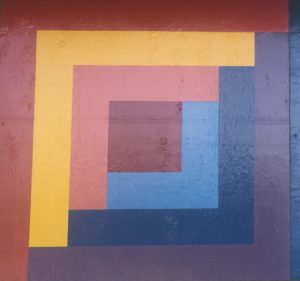
630 S. AR 9
Melbourne AR
#9-11, The Log Cabin, and #9-12, Dutch Doll, quilt blocks were painted by Candi Cooper (Log Cabin) and her daughter Avery (Dutch Doll). Located at 630 S. AR 9, Melbourne AR. Candi Cooper shares, “The log cabin quilt is the last quilt my granny, Veneda Long, made for me. I can remember being excited because I got to pick the pattern of the quilt as well as the fabric colors. I have other quilts that granny made for me as Christmas gifts but the log cabin is my favorite. Some years her gift at Christmas was a quilt for each family member. I know for both of my grannies and my great-grandma quilting was a necessity, but that wasn’t the case when I was growing up. However, I don’t remember a time when I was at my granny’s house that she didn’t have a quilt frame up in the bedroom, working on a quilt. I treasure the quilts I’ve been given and am thankful for all the time spent on making something that can be passed down and will last for decades. I try to carry on the tradition by making family members t-shirt quilts or denim quilts.”

630 S. AR 9
Melbourne AR
#9-12, Dutch Doll, is the companion block located at 630 S. AR 9, Melbourne AR. It was painted by Avery Cooper and this note was written by Avery’s mother, Candi Cooper: “The Dutch doll quilt was also one that my granny made. It was one that she had made that was extra, tucked in a closet. My mom had made me a Dutch doll quilt when I was a child so she wanted my daughter to have one as well. After granny got sick and went to the nursing home, my mom gave it to me for my daughter. My daughter now has hers on her bed. She loves the fact that her great-grandmother made it, even though she never got to meet her.” The Dutch Doll pattern is also named Sunbonnet Sue and came into popularity in the year 1900 when Bertha Corbett Melcher published a book, “The Sunbonnet Babies,” in which she depicted young girls with their faces hidden by bonnets. In the published applique patterns that followed, Sue is typically shown in profile, wearing a large bonnet and an over-sized pinafore dress, similar to the illustrations in Bertha’s books.
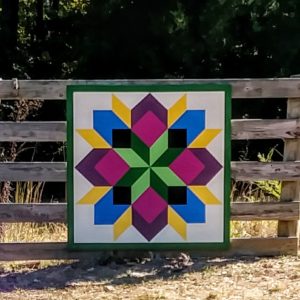
3300 South Bend Dr.
Horseshoe Bend AR
#9-13, The Promise is at 3300 South Bend Drive, Horseshoe Bend AR. This colorful 4 X 4 Starburst pattern quilt block can be found at the entry way to Horseshoe Angus Ranch, 3300 South Bend Drive in Horseshoe Bend in Izard County. Owners are Bill and Cindia Yancey. The block was lovingly painted by their daughter, Jessica Hogue, Independence County Quilt Trail Coordinator. Cindia named the quilt block, The Promise, because it reminds her of the colors in the rainbow and Gods covenant in Genesis 9. 12 And God said, “This is the sign of the covenant that I make between me and you and every living creature that is with you, for all future generations: 13 I have set my bow in the cloud, and it shall be a sign of the covenant between me and the earth. 14 When I bring clouds over the earth and the bow is seen in the clouds, 15 I will remember my covenant that is between me and you and every living creature of all flesh. And the waters shall never again become a flood to destroy all flesh”. HAR is nestled in the bend of the Strawberry River. Bill raises Registered Angus cattle and Cindia owns a jewelry shop located on the property. Cindia’s love of bead weaving colorful jewelry is another inspiration for the quilt block. In the nearby town of Franklin, where Cindia grew up, you can find historical buildings still standing. The old cotton gin on Highway 56 still stands as a monument of Izard County’s industrious past. The existing structure sits on the spot the original Boler Mill and Gin was located. The original gin and mill was erected in 1898 but burned in 1919 before the building that still stands was built. The old Bank of Franklin located on Main Street is still standing as well. The bank was organized in 1904. In 1920, as the bank prospered a new construction was moved across the street. In 1933, President Franklin Roosevelt called for a bank holiday in an effort to stabilize the nation’s economy. The Bank of Franklin is thought to be the only bank in the country that did not obey the Emergency Banking Act passed by Congress on March 9. When national bank examiners arrived in Franklin and commented on the bank being open, cashier Thomas W. Simpson replied that he had not received news of the law. Most historians accept his word, given the facts that Franklin had no telephone service in 1933 and the nearest railroad was fifteen miles away. https://exploreizard.blogspot.com/2010/10/franklin-gin.html

236 Chessmond Ferry Rd.
Calico Rock AR
#9-14, Judy Blue Eyes, is at 236 Chessmond Ferry Road, Calico Rock AR. Our quilt is the result of a rare and unexpected gift of extended time together during the fall of 2020. Emily is a quilter, Paul is handy and our mom Judy is a collector of vintage quilts, so we decided to combine our strengths and create a charming barn quilt based on Judy’s beautiful blue eyes and the song “Suite: Judy Blue Eyes.” We used elements of traditional quilting, including half square triangles and flying geese. The quilt block is located on the Sugg property, which has been part of Calico Rock history for over 100 years. The property where the quilt is located, and the old blue house on the corner are part of the Stoner addition which was an addition to the town of Calico Rock dating to the late 1800’s. Many of the old stone walls characteristic of the addition can be seen on this property and throughout the neighborhood. In the early 1900’s, the Rodman family came to Calico Rock and Mr. Rodman, who became president of the First National Bank of Izard County, built the blue house with white trim just to the east of where the barn quilt is displayed.

218 Chessmond Ferry Rd.
Calico Rock AR
#9-15, Constellations over Calico, is at The Old Rodman House, 218 Chessmond Ferry Rd., Calico Rock, AR. Ozark dwellers will appreciate the elements found in this quilt pattern with its unique combination of water, earth, forest, and sky colors radiating out from a white central square. Anywhere in the Ozarks, travelers can always enjoy inspiring views of mountains, rock bluffs, forests, and rivers. Often overlooked however, are the wonderful dark skies at night, allowing stargazers the opportunity to see many more stars and constellations than are visible from heavily lighted urban areas. Embedded in the night sky sections around the edges are a star and a crescent moon, along with 14 of the 88 constellations of the night sky seen from Calico Rock at different seasons of the year. How many constellations can you identify? The quilt design was inspired in part by the beautiful night skies and since there is a private astronomical observatory on the property, it was a good fit. For more information about the observatory seewww.eridanusobservatory.net. The design of Constellations Over Calico was inspired by traditional elements of quilting. Half square triangles were used at different angles to accomplish the double star block design. The color inspiration of the quilt comes from the river, the brown bluffs, the mixed hardwood and pine forests of the area, and the dark night skies of Calico Rock.
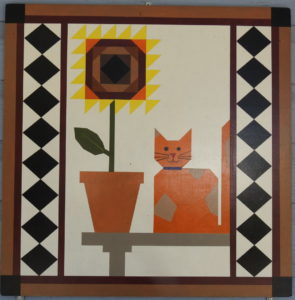
218 Chessmond Ferry Rd.
Calico Rock AR
While you’re there, be sure to see the small quilt block on the front porch, #9-15B, Calico Cat.

105 Peppersauce Alley
Calico Rock, AR
#9-16, Peppersauce Twist, is at 105 Peppersauce Alley, Calico Rock. This quilt is located high on the back of the Calico Rock Museum building. Calico Rock was quite a shopping center in the early 1900s with a sawmill, a cotton gin and a water-powered corn-grinding mill. Farmers would bring produce to Calico Rock and do their shopping there. Often they came from far enough away they would need to camp overnight in the wagon yard, which became known as Peppersauce Alley because of the moonshine whiskey traded there. The area along Peppersauce Alley has recently been renovated and enhanced by the businesses, the museum and the residents who live in some of the buildings. And there are plans to make it a part of the thriving Main Street in Calico Rock. The quilt pattern is named Twisting Star and was painted by Barbara Carlson.
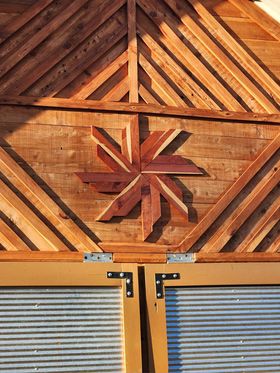
262 Jeffery Lane
Melbounre AR
#9-17, Pinwheel, is at 262 Jeffery Lane, Melbourne AR, more specifically, the Mt. Olive community. The Elijah Jeffery home, constructed prior to the Civil War, was a long-time landmark in the Mt. Olive community on the White River in Izard County. During the Civil War, it was to this home that Elijah’s son, Issac, was brought after being killed by Bushwhackers who raided the town. In later years after construction of the railroad, it became a boarding house for railroad workers, businessmen, and travelers through the town. By the middle of the 20th century, it had become vacant, fell into disrepair, and was eventually demolished in the early 2000’s. The only part remaining was the chimney. The property was purchased by Terry and Susan Smith in 2015 but it wasn’t until the fall of 2020 that positive changes began to occur. After bushhogging the lot, overgrown from the previous summer, interest was taken in the chimney, a fire built, and the crowd that gathered was amazed that the chimney drew as true and straight as it must have when originally constructed. One idea led to another, and over the following 3 years the chimney was repaired, a large surrounding floor poured, and a roof added. Currently, a kitchen/serving area is being completed and the structure has become a center for community gatherings.

Hwy 5 & Hwy 56
Calico Rock AR
#9-18, Calico Star, is located in the town of Calico Rock on the northwest corner of the intersection of Hwy 5 and Hwy 56. It was painted by John Biegel with color selection by Kathy Biegel. The use of calico material goes back centuries and has developed across three continents into the material we know today. Many quilt blocks have been sewn using calico material. When the early quilt making settlers moved into our area of north central Arkansas, they came to admire the multi-colored bluffs along the White River. Naturally they saw the similarity and those bluffs got their name. Or, they may have named them after calico cats but we’re not sure. The idea for adapting this quilt block pattern, Calico Star, to a barn quilt block stems from two associations. The first connection is with Calico Creek which flows through the town of Calico Rock, Arkansas and is across the street from where the barn quilt is located. The second connection is with a musical band called Calico Creek that included our friend Rick along with my wife Kathy and myself. While short-lived (we only played one gig) it involved a lot of fun and so this barn quilt painting is in tribute to that memory.
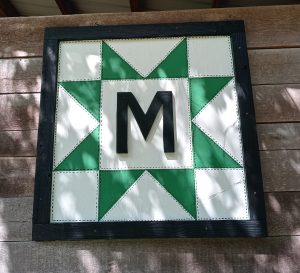
467 Ruddells Rd.
Mountain View AR
#9-19, Morgan Mountain Retreat, is located at 467 Ruddells Rd., Mountain View, AR. It’s on the Izard County side of the White River near Allison. Owner Carla Morgan shares its story. I am an avid quilter. I love it! When I moved to our quaint little town of Mountain View, Arkansas I was in awe of the beautiful quilt blocks displayed throughout our small business district. I talked my husband Robert into building me one to paint, so that I could feature it on our little barn for our guests to enjoy that stay here at Morgan Mountain Retreat. I do have Arkansas Quilt Trail brochures available in the cabin at Morgan Mountain Retreat for my guests to read about the history of the trail. So many of the ladies that have stayed in our cabin have also shared the same love of quilting, and I thought it would add a little nostalgia to their stay. Many of our guests return and stay with us again and again. I can’t wait for them to drive up and see my block! My block is 39 1/2 X 39 1/2. It is made out of treated plywood and rustic re-purposed wood. I painted it green to match our rental cabin. It is simple, but I like it!

1007 East Main St.
Melbourne AR
#9-20, Log Cabin Spirit, is at 1007 East Main St., Melbourne AR. Is positioned on the south side of the Izard County Library located at 1007 East Main St., Melbourne in Izard County. This very traditional quilt square draws its inspiration from the log cabins that the early pioneers constructed. Much like the various “pieces” were gathered together to create the quilt, the various logs were gathered and fitted together to make the cabin structure. Cabin building was often a neighborhood effort where folks came together in friendship and made a home for their new neighbors. In much this same spirit, the quilt trail coordinators from the Arkansas counties that boast a quilt trail met together for a day of friendship and shared ideas. The barn quilt you now see has had each of the “pieces” painted by a county representative. Pictured with Cathy Biegel.
I have really enjoyed looking and reading all about the beautiful quilt blocks and their history on the Izard County Trail!
These are amazing! I’m so excited to see Izard County represented in Arkansas Quilt Trails.
Thanks, Patricia. We’re glad to have Izard County as part of Arkansas Quilt Trails.
All are beautiful. Nice stories with each
Thanks, Claire. Glad you enjoyed the trail and the stories.
Thanks to all who made this possible. Very honored to be a part of it!
Thanks, Claire. Glad you are part of it!
[…] From that barn quilt came barn quilt trails. These trails can be seen throughout the U.S. Interestingly enough though, Izard County has its own barn quilt trail, which is featured here http://arkansasquilttrails.com/izardcounty/ […]